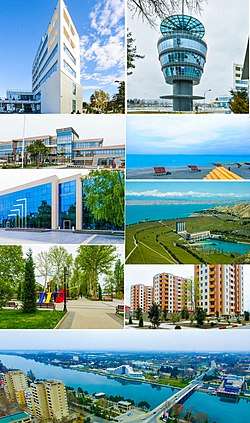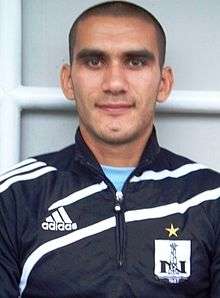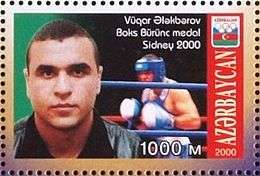Mingachevir
Mingachevir (Azerbaijani: Mingəçevir), is the fourth-largest city in Azerbaijan with a population of about 104,500. It is known as city of lights because of its hydroelectric power station on the Kur River, which splits the city in half.
Mingəçevir Mingəçevir | |
|---|---|
 | |
 Seal | |
 Mingəçevir | |
| Coordinates: 40°46′12″N 47°02′56″E | |
| Country | |
| City | Mingachevir |
| Founded | 1946 |
| Area | |
| • Total | 47 km2 (18 sq mi) |
| Elevation | 545 m (1,788 ft) |
| Population (01.01.2020)[1] | |
| • Total | 106,048 |
| • Density | 2,300/km2 (5,800/sq mi) |
| Time zone | UTC+4 (AZT) |
| Area code(s) | +994 024 27 |
| Website | Official website |
The area has been settled for thousands of years, but the current city was founded in 1948, partly by German soldiers who were taken prisoner during World War II.[2] Mingechevir is also home to Mingachevir Polytechnic Institute. The city forms an administrative division of Azerbaijan. The district is located 323 km from Baku and 17 km from the Baku-Tbilisi railway. Geographically, the region is located in the center of the republic on both side of the Kura river.[3]
History
Despite the fact that Mingachevir is a young town, the territory where the town is located is known as an ancient abode. The history of this abode covers a period from the eneolith era (3000 BC) to the AD 17th century. It was the chairman of the Caucasus archeological committee, A. I. Berje, who first gave information about the archeological monuments of Mingachevir at the second congress of archeologists in St Petersburg in 1871. Although this information was not precise, Berje presented Mingachevir as an ancient settlement
After this, Mingachevir remained out of archeologists’ attention for many years. Archeological researches resumed in Mingachevir only in mid-1930s as part of the construction of the hydroelectric power station. The researches started under the leadership of Prof. Pakhomov in 1935. These researches revealed two ancient settlements and cemeteries, which were composed of various types of graves. Unfortunately, World War II prevented the research being completed.
The construction of the hydroelectric power station started immediately after the war. This marked a start of systematic and planned research of Mingachevir as an ancient abode. Archeological excavations were carried out from April 1946 to August 1953 by a group of archeologists headed by S. M. Qaziyev in connection with the construction of the Mingachevir hydroelectric power station under a decision by the Supreme Board of the Azerbaijani Academy of Sciences. Over 20,000 historical monuments – graves and tumuli, means of production, things related to daily life, jewelry etc., which reflected historical periods in chronological sequence, were found during the excavations.
Most ancient written monuments in Caucasian Albanian alphabet and other archeological finds proved that Mingachevir was a 5,000-year-old abode. The majority of these finds are currently exhibited in the Azerbaijani Historical Museum, while part of them is held at the Mingachevir Historical Museum.
History knows a great deal of facts about ancient Mingachevir. Historical sources indicate that a fierce battle took place between the powerful army of Roman commander Pompey and the army of Albanian governor Oris just on the territory of the current dam on the bank of the River Kur in the 1st century BC. Historical facts also prove that the ancient Silk Road ran via Mingachevir.[4]
Renowned Turkish traveler Evliya Çelebi, who lived in the 17th century AD, wrote about Mingachevir and described it as a large settlement on the right bank of the River Kur near the Bozdag Mountain. According to him, several mosques, workshops manufacturing fiber silk and silk cloth, bathhouses etc. were operating in this settlement. The road passing from there used to be called the "road of messenger". The "road of messenger" connected camelcade and trade roads to Middle East countries and Azerbaijani towns like Saki, Qabala, Samaxi, Barda, Beylaqan and others.
A great number of people came to Mingachevir from all districts in Azerbaijan in connection with the construction of the Mingachevir hydroelectric power station, and a total of 20,000 people took part in the construction of this power station. About 10,000 German POWs were among those who contributed to the construction of the power station by the end of the 1940s. The most experienced specialists of the country were involved in the construction of this building site as the biggest hydroelectric power station of the then Soviet Union.
Today's Mingachevir was granted the status of city in 1948. The population of the town currently stands at 120,000 people, including 20,000 internally displaced people from Karabakh and the occupied adjacent districts. The area of the town is 139.53 km². Mingachevir is situated 55 meters above sea level on the foothill of the southeast of the Bozdag Mountain chain and on the edge of the Mingachevir reservoir in the Kur-Araz lowland in central Azerbaijan. The town was built in a mild and warm zone and has warm and dry summers and mild winters. The average annual temperature is 14 - 15 °C, highest temperature 42 °C (July–August) and the lowest temperature (January–February) -10 °C. The average annual rainfall is 250–300 mm.
The town lies on both banks of the River Kur - a 1515 km-long river, which is the biggest and longest one in the South Caucasus. (The river originates from Turkey, runs down Georgia and Azerbaijan and flows to the Caspian Sea.) Mingachevir is situated in 280–300 km west of the capital of the republic, Baku.
Mingachevir has been developing speedily over the last 54 years, since it has been established. It is currently considered to be the fourth city of the country both for its economic potential and the number of inhabitants, it is one of the most important cities of the republic in terms of energy, industry, science, education and culture. The number of able-bodied people in Mingachevir is 53,000, while the number of people actually involved in labor is 16,000. The number of people engaged in small-sized businesses stands at 4,000 people[5]
Economy
As of 2008, Mingachevir fish farm functions in the city, which farms three types of fishes, including carp, silver carp and sturgeon.[6]
Reservoir and hydroelectric power station
The construction of the Mingachevir Dam creating the Mingachevir reservoir and Mingachevir Hydro Power Plant was completed in 1953.[7] The hydroelectric power stations soil dam, whose total capacity is 15.6 cubic kilometers of water, is one of the highest dams in Europe that was constructed through sprinkling.[8] The reservoir is located 3 km north-west of the district. The length of the reservoir is 70 km, width from 3 to 18 km, deepest point about 75 meters and total area 605 km².[3]
Apart from the River Kur, the reservoir feeds two channels of the 172 km-long Upper Qarabag Channel and the 123 km-long Upper Sirvan Channel. These channels are used to irrigate 10,000 square kilometres of area in the steppes of Mil, Mugan and Sirvan. The Varvara reservoir and the Varvara hydroelectric power station are in 20 km east from the Mingachevir reservoir on the River Kur. The volume of the Varvara hydroelectric power station's energy blocks is 16 MW.[9]
Demographics
| Years | thsd. persons |
|---|---|
| 2010 | 96.9 |
| 2011 | 97.8 |
| 2012 | 98.8 |
| 2013 | 99.7 |
| 2014 | 100.6 |
| 2015 | 101.6 |
| 2016 | 102.4 |
| 2017 | 103.2 |
| 2018 | 104.5 |
Ethnic groups
According to the 2009 census, the total population of the city is 96,304, including 95,700 Azerbaijanis, 413 Russians, 52 Lezgins and others.[11]
| Mingechevir | 96304 | 100,0 | 46492 | 100,0 | 49812 | 100,0 |
| including | ||||||
| Azerbaijanis | 95700 | 99,37 | 46355 | 99,7 | 49345 | 99,1 |
| Russians | 413 | 0,43 | 87 | 0,2 | 326 | 0,7 |
| Lezgins | 52 | 0,05 | 23 | 0,0 | 29 | 0,1 |
| Tatars | 38 | 0,04 | 5 | 0,0 | 33 | 0,1 |
| Ukrainians | 20 | 0,02 | 0 | 0,0 | 20 | 0,0 |
| Turkish people | 16 | 0,02 | 8 | 0,0 | 8 | 0,0 |
| Kurds | 7 | 0,01 | 3 | 0,0 | 4 | 0,0 |
| Avars | 6 | 0,01 | 0 | 0,0 | 6 | 0,0 |
| Georgians | 6 | 0,01 | 2 | 0,0 | 4 | 0,0 |
| Others | 46 | 0,05 | 9 | 0,0 | 37 | 0,1 |
Religion
- Muslim 95%
- Other 5%
Climate
Mingachevir has a semi-arid climate (Köppen climate classification: BSk) near the borderline of a humid subtropical climate (Köppen climate classification: Cfa) because its fairly evenly distributed average annual precipitation is just below the 400 mm threshold, apart from the average annual temperature range.
| Climate data for Mingachevir | |||||||||||||
|---|---|---|---|---|---|---|---|---|---|---|---|---|---|
| Month | Jan | Feb | Mar | Apr | May | Jun | Jul | Aug | Sep | Oct | Nov | Dec | Year |
| Average high °C (°F) | 7.1 (44.8) |
8.6 (47.5) |
12.9 (55.2) |
20.9 (69.6) |
26.0 (78.8) |
30.0 (86.0) |
33.9 (93.0) |
32.6 (90.7) |
28.4 (83.1) |
21.0 (69.8) |
14.4 (57.9) |
9.3 (48.7) |
20.4 (68.8) |
| Average low °C (°F) | −4.0 (24.8) |
−3.0 (26.6) |
4.0 (39.2) |
9.3 (48.7) |
14.2 (57.6) |
18.6 (65.5) |
21.6 (70.9) |
20.6 (69.1) |
17.0 (62.6) |
11.1 (52.0) |
6.2 (43.2) |
1.4 (34.5) |
9.8 (49.6) |
| Average precipitation mm (inches) | 19 (0.7) |
25 (1.0) |
27 (1.1) |
39 (1.5) |
54 (2.1) |
49 (1.9) |
26 (1.0) |
27 (1.1) |
26 (1.0) |
53 (2.1) |
30 (1.2) |
22 (0.9) |
397 (15.6) |
| Source: Climate-Data.org | |||||||||||||
Culture
Sixteen public libraries, containing a total of 406,677 books, operate in the town.[13] The number of subscribers in these libraries stands at 46,282 people.[13] Every book is requested 2.9 times on average annually, and readers took books from libraries 904,395 times in 2011.[13]
The Davudova Mingacevir State Theatre was established on the basis of folk theatre in 1969.[14] Every clubhouse has its own ensemble. There are also singing and music circles, as well as training courses on computers, tailoring, board games and arts in the clubhouses. There are 8 clubhouses, including the Martyr Azar Niftaliyev clubhouse, Samad Vurgun clubhouse, Nariman Narimanov clubhouse and others, in the town.
Museums
The Mingacevir Historical Museum was established in January 1968. The museum has two branches – Martyrs’ Memorial and Independence Museum. The museum has 14,461 exhibits. The city is also home to Mingachevir Gallery, which includes 310 works of art by Azerbaijani and Russian artists, including works by Mikhail Vrubel and Ilya Repin.[15]
Music and media
There are 3 musical schools – Hacibayov School, Bulbul School and Martyr Qasimov School functioning in the city. The study in these schools lasts 7 years. A total of 1,500 students attend these schools, and 350 professional teachers train them. The schools have different courses on tar, kamanca, nagara, saz (national musical instruments), piano, violin and vocal.
The regional channel Mingachevir TV is headquartered in the city.[16]
Parks and gardens
The city has many parks, including Sahil Park and Friendship Park.[17]
Sports
The city has one professional football team, Energetik, competing in the top-flight of Azerbaijani football - the Azerbaijan First Division.
The city also contains high modern rowing Kur Sport and Rowing Centre, which was renovated and unveiled in 2010.[18][19] The venue expected to host canoe sprint at 2015 European Games.[20]
Transportation
Public system
Mingachevir's trolleybus system at its height, it consisted of three lines and existed until 2005.[21]
Education
Mingachevir State University, founded in 1991, is the oldest Azerbaijani educational institution in the city. Although originally part of Azerbaijan State Oil Academy, the institute became independent in 1991.[22] Mingachevir Medical School, founded in 1991, includes 17 study halls for anatomy, therapy, surgery and pediatrics. The city also includes the local branch of the Azerbaijani Teachers Training Institute.[23]
Notable residents
Some of the city's many prestigious residents include: footballer Ruslan Amirjanov, politicians Aydin Mirzazade, Fizuli Alakbarov and Yaqub Eyyubov
 Ruslan Amirjanov, footballer.
Ruslan Amirjanov, footballer. Vugar Alakbarov, boxer.
Vugar Alakbarov, boxer.- Yaqub Eyyubov - First Deputy Prime Minister of Azerbaijan
International relations
Twin cities
Mingachevir is twinned with the following cities:
References
- "Archived copy". Archived from the original on 2015-11-09. Retrieved 2015-09-13.CS1 maint: archived copy as title (link)
- "German POW cemetery in Mingechevir". Archived from the original on 2014-09-20. Retrieved 2018-11-28.
- "Coğrafi mövqeyi - MİNGƏÇEVİR ŞƏHƏR Icra Hakimiyyəti". mingechevir-ih.gov.az. Archived from the original on 2018-11-29. Retrieved 2018-11-29.
- Thomas Höllmann: Die Seidenstraße. Munich 2018. p. 83.
- "Territorial and Administrative units of Azerbaijan" (PDF). Archived (PDF) from the original on 2018-10-05.
- Bayramova, Jeyran. "Gone Fishing to Mingechevir -Saving the Sturgeon-". www.visions.az. Archived from the original on 20 September 2014. Retrieved 13 November 2014.
- "Rivers, Lakes and Reservoirs of Azerbaijan Republic". Ministry of Ecology and Natural Resources (Azerbaijan). Archived from the original on 2 July 2014. Retrieved 11 June 2014.
- "Mingachevir Hydro Power Plant". Archived from the original on 2012-02-17. Retrieved 2014-11-13.
- "Archived copy". Archived from the original on 2016-02-04. Retrieved 2016-03-20.CS1 maint: archived copy as title (link)
- Political division, population size and structure: Population by towns and regions of the Republic of Azerbaijan. "Population | The State Statistical Committee of the Republic of Azerbaijan". The State Statistical Committee of the Republic of Azerbaijan. Archived from the original on 2018-08-27. Retrieved 2018-11-28.
- "Aran iqtisadi rayonu: Mingəçevir şəhəri". The official website of State Statistics Committee of Azerbaijan. Archived from the original on 2018-06-15.
- "Climate: Mingachevir". Archived from the original on 2016-03-04. Retrieved 2016-02-27.
- "Nurlu şəhər". www.anl.az (in Azerbaijani). Archived from the original on 13 November 2014. Retrieved 13 November 2014.
- "Mingəçevir Dövlət Dram Teatrının 45 illik yubileyi qeyd edilmişdir" (in Azerbaijani). Archived from the original on 13 November 2014. Retrieved 13 November 2014.
- "Azərbaycan Respublikasının Mədəniyyət və Turizm Nazirliyinin strukturu". elibrary.az (in Azerbaijani). Archived from the original on 10 November 2014. Retrieved 10 November 2014.
- "Radio-TV yayımı" (in Azerbaijani). Archived from the original on 27 October 2014. Retrieved 13 November 2014.
- "Sahil parkı "gəl, gəl" deyir" (in Azerbaijani). Archived from the original on 13 November 2014. Retrieved 13 November 2014.
- "Azerbaijan to put 6 more Olympic Sport Complexes into operation this year". Archived from the original on 3 October 2011. Retrieved 21 August 2011.
- "Speech by Ilham Aliyev at the ceremony held at the National Olympic Committee to award sportsmen and coaches". Archived from the original on 7 November 2014. Retrieved 21 August 2011.
- "Mingachevir Venue Facts". www.baku2015.com. Archived from the original on 7 November 2014. Retrieved 7 November 2014.
- "14. Мингечаур (троллейбус)" [14. Mingečaur (trolleybus)]. Горэлектротранс (Electrotrans) website (in Russian). Дмитрий Зиновьев (Dmitry Zinoviev). Archived from the original on 4 January 2013. Retrieved 23 September 2012.
- "MİNGƏÇEVİR POLİTEXNİK İNSTİTUTU". www.mpi.edu.az (in Azerbaijani). Archived from the original on 13 November 2014. Retrieved 13 November 2014.
- "Müəllimlər İnstitutu Mingəçevir filialının direktoru işdən qovuldu". moderator.az (in Azerbaijani). Archived from the original on 13 November 2014. Retrieved 13 November 2014.
- "Тольятти и Мингечаур (Азербайджан) - города побратимы". www.regnum.ru. Archived from the original on 14 December 2014. Retrieved 13 November 2014.
- "Azerbaycan Heyetinden Gölbaşı Belediyesi'ne Ziyaret" (in Turkish). Archived from the original on 13 November 2014. Retrieved 13 November 2014.
- "Polotsk signs agreements with Azerbaijani Mingachevir, Armenian Alaverdi". eng.belta.by. Archived from the original on 24 December 2014. Retrieved 13 November 2014.
- "Mingəçevirlə Qars arasında "Qardaşlaşma" sazişi imzalandı". Trend.Az (in Azerbaijani). 2016-07-26. Archived from the original on 2018-11-29. Retrieved 2018-11-28.
- "Мингечевир и Афула стали городами-побратимами" (in Russian). Archived from the original on 3 February 2018. Retrieved 9 July 2015.
External links
| Wikimedia Commons has media related to Mingachevir. |